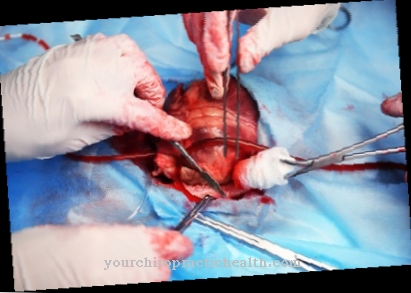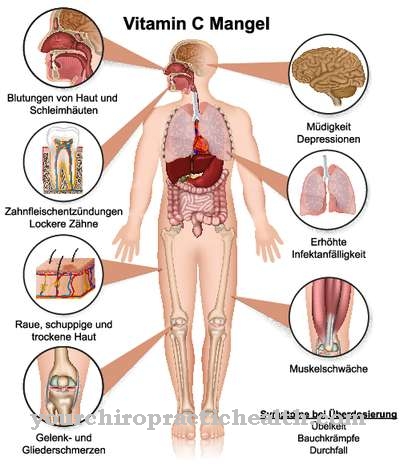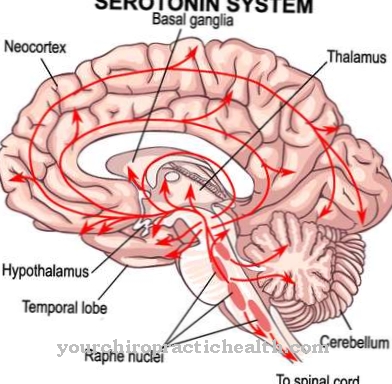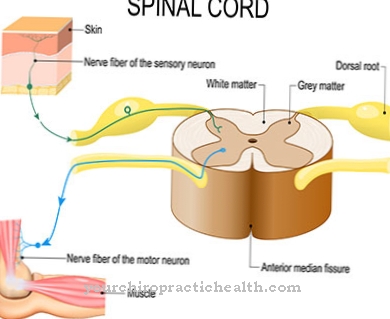Under the Optic atrophy medicine understands the breakdown of the optic nerve cells, as it can be present in the context of various primary diseases. The autoimmune disease multiple sclerosis is one of the most common causes of optic nerve inflammation and the resulting octicular atrophy. Treatment for atrophy depends on the cause.
What is optic atrophy?

© Artemida-psy - stock.adobe.com
The Optic atrophy is a degenerative tendon disease. As part of the disease, the nerve cells break down along the optic nerve. The loss of cells can lead to blindness. Optic atrophy is thus one of the most common causes of blindness. In adolescents and children, the disease is usually much faster and more severe than in older people. Several forms of atrophy are distinguished according to cause and appearance.
Simple optic atrophy is characterized by sharp borders and is usually not inflammatory. The secondary forms, on the other hand, are often preceded by inflammation. The incomplete atrophy only partially degrades the optic nerve and is characterized by temporal papillary bleaching. A distinction is to be made between these three forms and the hereditary forms, which can occur in the context of various hereditary diseases. The nerve tissue atrophy is either unilateral or bilateral. The nerve fibers can also be affected by the breakdown processes, as can the surrounding myelin sheath.
causes
In principle, all lesions and diseases of the optic nerve can cause atrophy. Increased intracranial pressure with papillae congestion is just as likely a trigger as a traumatic optic nerve lesion or glaucoma. Just as often, the degenerative phenomenon is preceded by optic neuritis or ischemia.
Nerve compressions are also conceivable, for example those in the context of a superior orbital fissure syndrome, a meningioma of the optic sheath or a tumor in the junction of the optic nerve. Toxic causes due to alcohol, tobacco, quinine, arsenic, lead or bromine must be distinguished from these causes. The hereditary form of optic atrophy can in turn occur in the context of diseases such as Behr syndrome I, motor-sensitive neuropathy VI, girdle dystrophy 2O or Tay-Sachs syndrome, Cohen syndrome and metachromatic leukodystrophy. If there is primary atrophy, malfunctions in the subcellular tissue are the cause.
Symptoms, ailments & signs
The symptoms of optic atrophy differ depending on the cause. The cause decides, for example, whether the optic nerve degrades on one or both sides. The subjective perception of the symptoms is also different and ranges from subjectively perceived lack of symptoms to reduced visual acuity and visual field defects. The visual field defects are the most characteristic symptom of the disease.
These failures have different characteristics. Mostly they go back to an increasing loss of central visual acuity, which can increase to blindness. The color perception of those affected is often disturbed. The same applies to the dark adaptation of the eyes. Sometimes there is also a disorder of the pupillary reaction. Hereditary disorders in particular show a progressive course that often ends in amaurosis. As a rule, patients do not complain of pain. In the case of inflammation-related atrophy, however, slight pain cannot be ruled out.
Diagnosis & course of disease
The diagnosis of optic atrophy includes anamnesis, a visual acuity test and perimetry. Fundus copies can also help the doctor make a diagnosis. The optic nerve and the orbital or intracranial structures are visualized with an imaging method such as MRI. Possible causes such as masses can be read from the imaging. The fundus is examined using an ophthalmoscopy.
With this procedure, optic atrophy usually shows a bleaching, which is accompanied by discoloration of the papilla. The course of the disease depends on the cause. With hereditary progressive forms of atrophy, a rather poor prognosis is often to be expected. This form often leads to blindness.
Optic nerve damage that has already occurred is irreversible. Under certain circumstances, depending on the cause of the disease, further damage can be prevented in the future. For the doctor, optic atrophy as a symptom of various diseases is sometimes of diagnostic value.
Complications
As a rule, the complications and also the symptoms of optic atrophy depend very much on their cause. In any case, those affected suffer from visual problems with this disease. The optic nerve and the associated cells are broken down, so that there can be visual problems or, in the worst case, even complete loss of vision.
Losses in the visual field can also occur due to optic atrophy and continue to significantly reduce the patient's quality of life. Likewise, during blindness, the different colors may be disturbed. However, there are no particular pain or other complications. Especially in young people or children, blindness can lead to severe psychological complaints and also to depression.
For this reason, they are also dependent on psychological treatment for optic atrophy. However, life expectancy itself is not influenced by optic atrophy. Direct treatment is not possible. Especially after going blind, eyesight cannot be restored. If the optic atrophy is caused by inflammation, it may be treated with antibiotics. Tumors are removed using radiation therapy.
When should you go to the doctor?
If there is a loss of nerve cells on the optic nerve in one eye, a doctor's visit is essential. The right contact person is an ophthalmologist. Optic atrophy leads to visual field loss in both mild and severe cases. There is a loss of visual acuity. Regardless of whether the sequelae are severe or not, a visit to a doctor is advisable as the optic atrophy is progressive.
The diagnosis cannot be made without a reflection of the fundus. Then the search for the cause of the disease begins. Optic atrophy is triggered by causes as diverse as inflammation of the optic nerve, increased intracranial pressure, but also by chronic alcohol or tobacco intoxication. It is important to treat the causes of the optic atrophy as well. Therefore, they need to be determined whenever possible. Whether the atrophy of the nerve cells occurred as a result of or during another disease is of secondary importance for the treatment.
An MRI scan may provide information about how far the optic atrophy has progressed. At the end of the progressive degeneration of the nerve cells, blindness occurs. The problem is that optic atrophy can also occur in children. In this case, the damage to the nerve cells is usually rapid. Therefore, the ophthalmologist should be seen earlier in children than in adults. Early detection and immediate treatment play a key role in optic degeneration.
Treatment & Therapy
Since the damage to central nerves is irreversible, there is no complete cure option for optic atrophy that has already occurred. The treatment depends on the causal disease. While some hereditary forms of atrophy cannot be treated, other causes of degeneration can be treated causally or even cured. In particular, optic nerve inflammation can usually be treated at least symptomatically.
In most cases, the primary disease associated with optic nerve inflammation is the autoimmune disease multiple sclerosis, the cause of which has not yet been treated. However, an inflammatory MS flare-up in the optic nerve can often be interrupted by drugs such as cortisone in order to save the nerve. The recurrence of the inflammation is not excluded. In the case of bacterial infectious diseases of the optic nerve, the doctor will administer antibiotics that can penetrate the liquor and thus control the damage to the optic nerve.
Causal tumors are removed as far as possible or treated with radiation therapy. If, on the other hand, increased intracranial pressure has caused the optic atrophy, a reduction in pressure is induced, for example by draining the cerebral fluid. For causal glaucoma, drug therapies and laser treatments are possible therapeutic options.
You can find your medication here
➔ Medicines for visual disturbances and eye complaintsOutlook & forecast
In optic atrophy, it is important to treat the underlying disease as quickly as possible. This is the only way to avoid irreparable damage. This means that the prognosis is poor in the absence of treatment. Damage to the optic nerve is irreparable. They ensure that the ability to see is permanently severely restricted.
The question now is what factors led to optic atrophy. All treatment options, as well as the expected prognosis, are defined by the underlying disease causing it. These can be tumors, increased intracranial pressure, alcohol poisoning, viral diseases of the eye or other triggers.
Because of the diversity of the triggers, an identical prognosis cannot be given for all cases. The prognosis is initially based on the general health of the eye. In addition, it depends on the quick and successful treatment of the triggering disease, which affects the optic nerve.
The therapy of a viral disease is tedious. However, according to a study, Leber's hereditary optic neuropathy can be successfully progressed by the drug idebenone. This is proof that an underlying disease that is treated early and consistently can keep the resulting optic atrophy low. The death of the nerve cells on the optic nerve cannot be prevented. But if you start therapy early, you can largely maintain your usual eyesight.
prevention
As a rule, optic atrophy cannot be prevented. This is especially true if the degenerative phenomenon occurs in the context of hereditary diseases or multiple sclerosis.
Aftercare
In most cases, those affected have very few follow-up measures available for optic atrophy. First and foremost, a doctor must be contacted at an early stage in this disease so that there are no other compilations or a further worsening of the symptoms. As a rule, self-healing cannot occur, so that those affected with this disease are always dependent on a medical examination and treatment.
The earlier a doctor is consulted, the better the further course of the disease is usually. Those affected are dependent on the intake of different drugs. The correct dosage with regular intake must always be observed in order to alleviate the symptoms permanently and, above all, in the long term.
Regular checks and examinations by a doctor are also very important, as they monitor and control the current state of the body. In many cases, however, those affected are dependent on the help and care of their own families. Loving conversations are also very important here, as this can prevent depressive moods or other mental illnesses.
You can do that yourself
Patients with optic atrophy must wear appropriate visual aids. In order to preserve or even improve the ability of the eyes to see, we recommend vision training and targeted protection of the eyes. Anyone who sits in front of the screen for several hours a day should take a break once or twice an hour. Eye drops can help relax the eyes. Affected people should talk to the doctor about supportive measures and implement them in a targeted manner. The cause of the optic atrophy cannot be treated, but the measures mentioned can stabilize eyesight and thus improve well-being in the long term.
People who, despite having glasses, suffer from visual disturbances or other complaints such as headaches or dizziness should inform their doctor. There may be another condition that needs to be diagnosed. In the case of optic atrophy, the eyes should also not be exposed to strong external stimuli such as direct sunlight or drafts. Hygiene measures such as regular dusting and the weekly change of bed linen help protect the eyes and prevent further deterioration in eyesight.
In addition to glasses, contact lenses or an operation in which the eyesight is improved via laser treatment are also available. After such an operation, it is essential to follow the doctor's instructions in order to avoid permanent damage to the eye and to ensure optimal recovery.


.jpg)


.jpg)





















